Business Accounting Assignment: Questions and Detailed Solutions
VerifiedAdded on 2022/11/30
|15
|2371
|78
Homework Assignment
AI Summary
This comprehensive document provides detailed solutions to a variety of business accounting questions. It begins with basic double-entry bookkeeping, including the double-entry equation and the dual aspect of transactions. It then moves on to ledger accounts, trial balances, and the preparation of profit and loss statements and balance sheets. The assignment also covers capital versus revenue expenditure, control accounts, financial ratios, and investment appraisal techniques such as net present value and payback period. Furthermore, the document includes discussions on the role of accountants, the impact of limited liability, the importance of accounting knowledge for non-accountants, statutory requirements for management accounting, and the nature and purpose of accounting. Finally, it defines key accounting terms such as depreciation, allowance for bad debts, debentures, preference shares, and ordinary shares. This resource is designed to provide students with a thorough understanding of core accounting concepts and practical application.
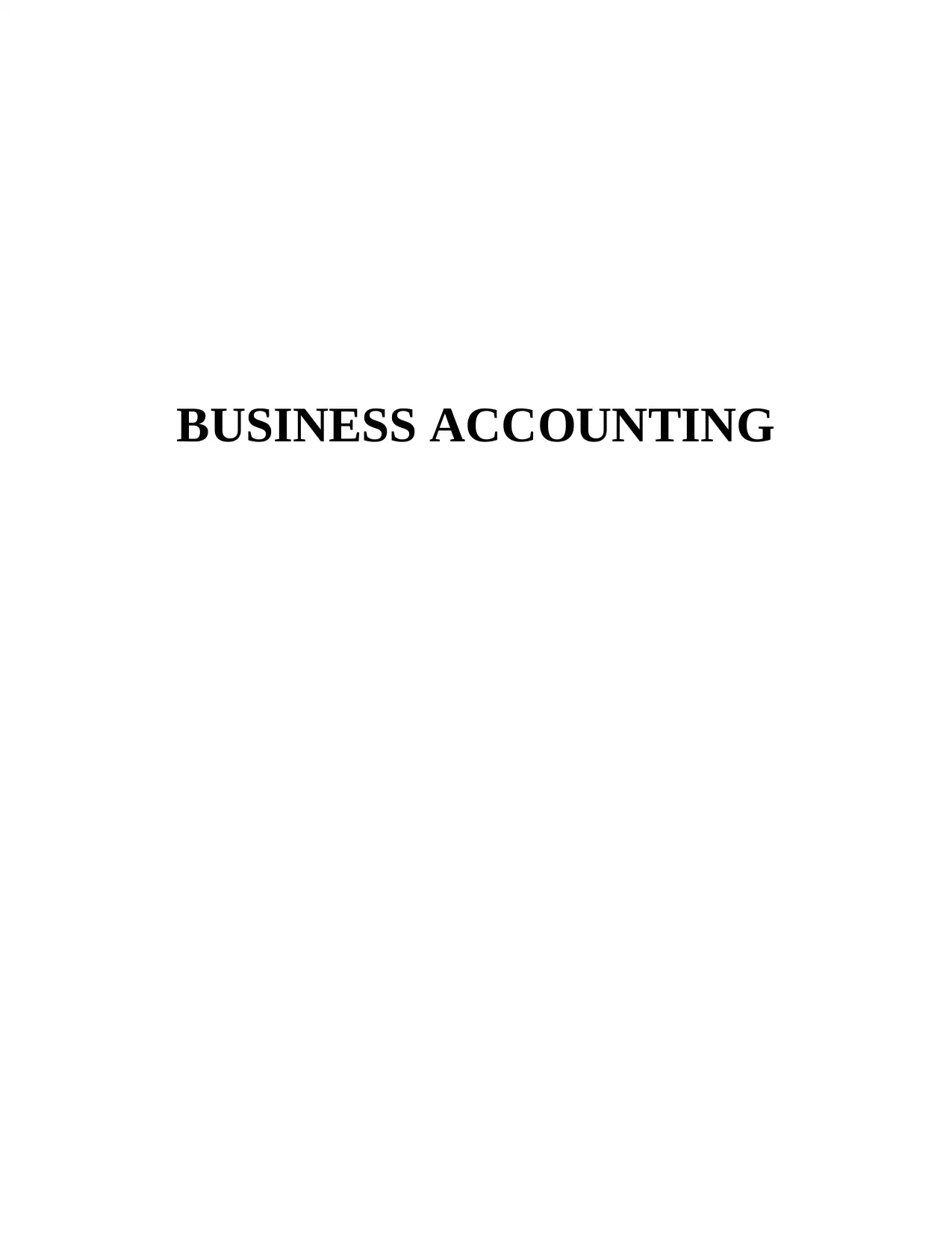
BUSINESS ACCOUNTING
Paraphrase This Document
Need a fresh take? Get an instant paraphrase of this document with our AI Paraphraser
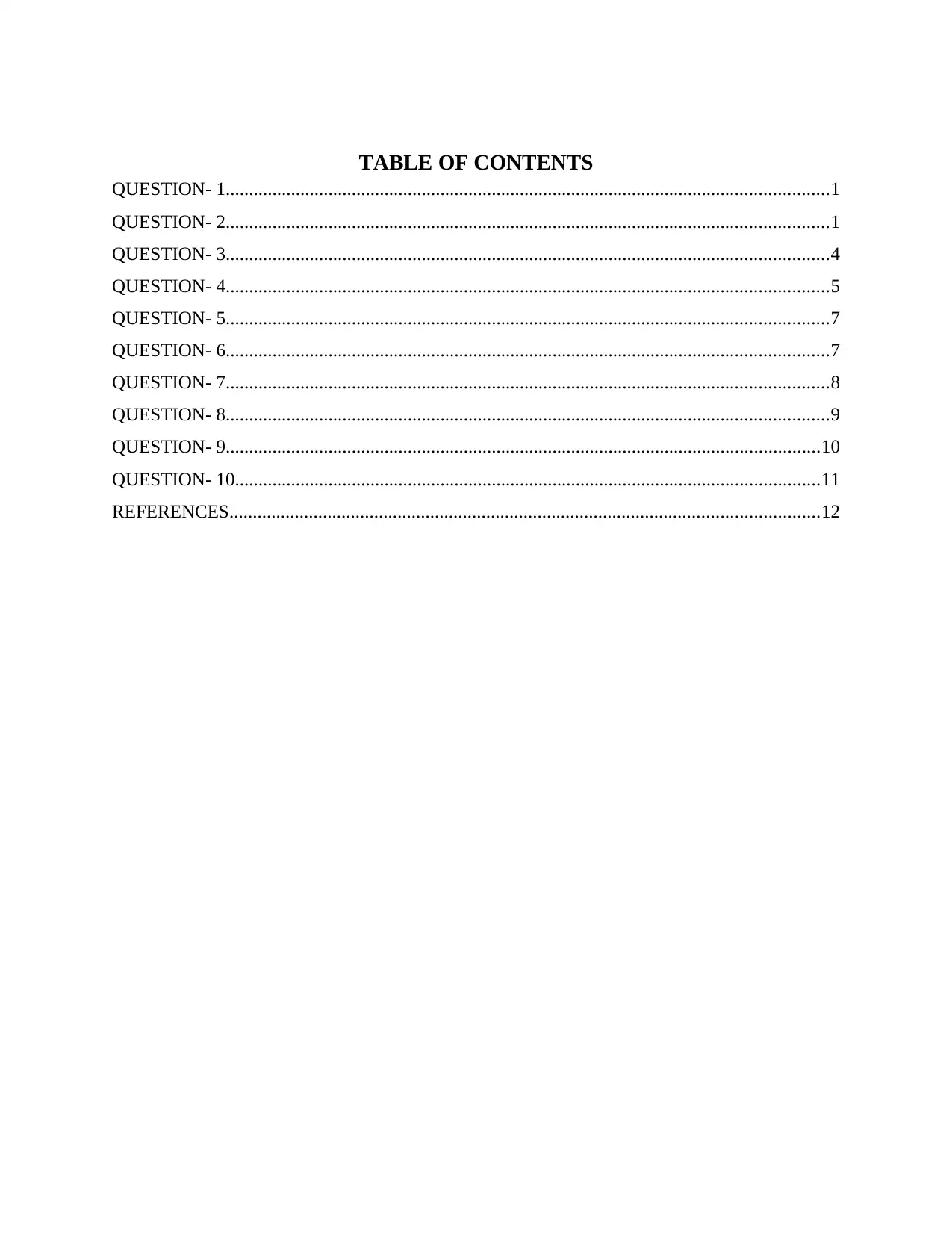
TABLE OF CONTENTS
QUESTION- 1.................................................................................................................................1
QUESTION- 2.................................................................................................................................1
QUESTION- 3.................................................................................................................................4
QUESTION- 4.................................................................................................................................5
QUESTION- 5.................................................................................................................................7
QUESTION- 6.................................................................................................................................7
QUESTION- 7.................................................................................................................................8
QUESTION- 8.................................................................................................................................9
QUESTION- 9...............................................................................................................................10
QUESTION- 10.............................................................................................................................11
REFERENCES..............................................................................................................................12
QUESTION- 1.................................................................................................................................1
QUESTION- 2.................................................................................................................................1
QUESTION- 3.................................................................................................................................4
QUESTION- 4.................................................................................................................................5
QUESTION- 5.................................................................................................................................7
QUESTION- 6.................................................................................................................................7
QUESTION- 7.................................................................................................................................8
QUESTION- 8.................................................................................................................................9
QUESTION- 9...............................................................................................................................10
QUESTION- 10.............................................................................................................................11
REFERENCES..............................................................................................................................12
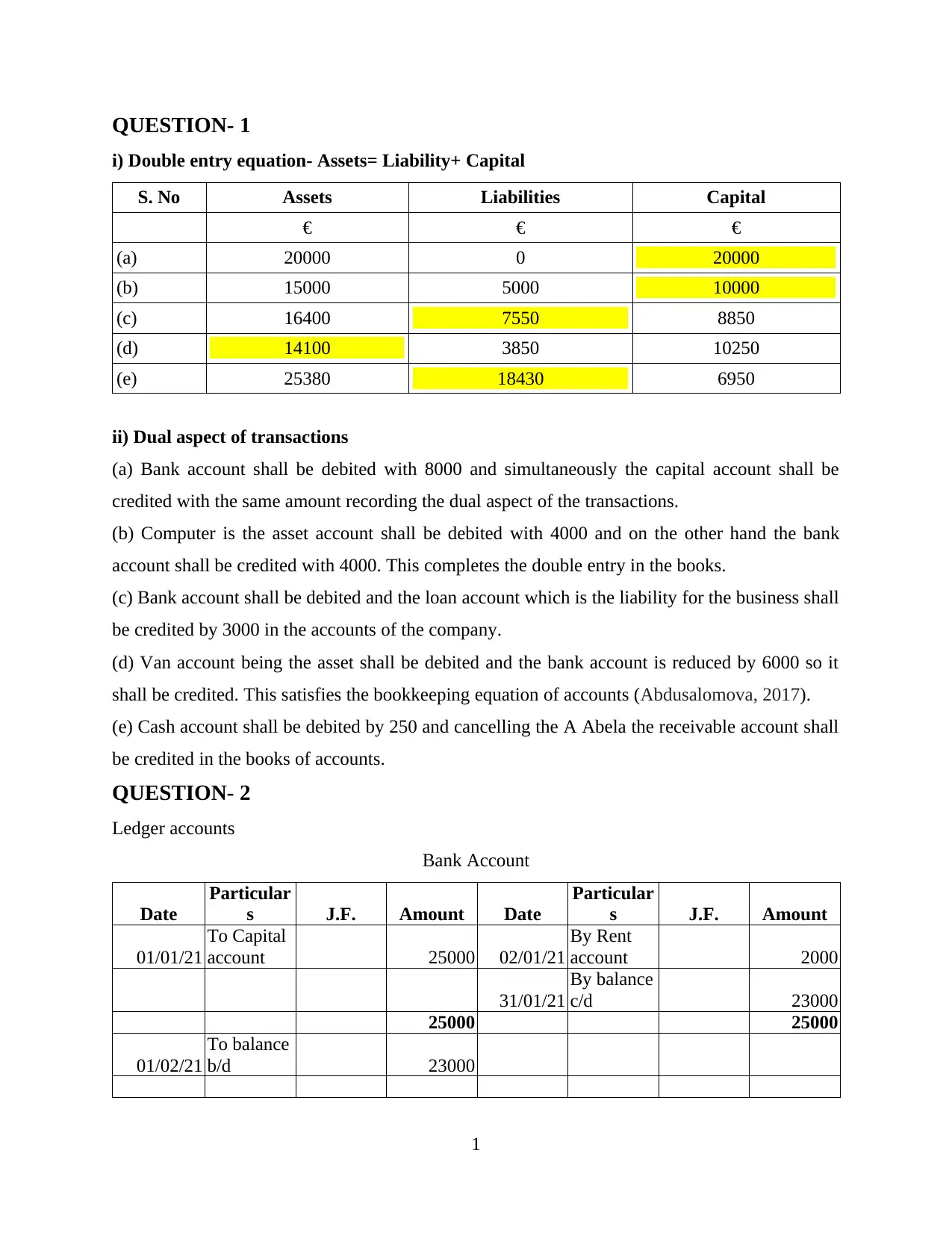
QUESTION- 1
i) Double entry equation- Assets= Liability+ Capital
S. No Assets Liabilities Capital
€ € €
(a) 20000 0 20000
(b) 15000 5000 10000
(c) 16400 7550 8850
(d) 14100 3850 10250
(e) 25380 18430 6950
ii) Dual aspect of transactions
(a) Bank account shall be debited with 8000 and simultaneously the capital account shall be
credited with the same amount recording the dual aspect of the transactions.
(b) Computer is the asset account shall be debited with 4000 and on the other hand the bank
account shall be credited with 4000. This completes the double entry in the books.
(c) Bank account shall be debited and the loan account which is the liability for the business shall
be credited by 3000 in the accounts of the company.
(d) Van account being the asset shall be debited and the bank account is reduced by 6000 so it
shall be credited. This satisfies the bookkeeping equation of accounts (Abdusalomova, 2017).
(e) Cash account shall be debited by 250 and cancelling the A Abela the receivable account shall
be credited in the books of accounts.
QUESTION- 2
Ledger accounts
Bank Account
Date
Particular
s J.F. Amount Date
Particular
s J.F. Amount
01/01/21
To Capital
account 25000 02/01/21
By Rent
account 2000
31/01/21
By balance
c/d 23000
25000 25000
01/02/21
To balance
b/d 23000
1
i) Double entry equation- Assets= Liability+ Capital
S. No Assets Liabilities Capital
€ € €
(a) 20000 0 20000
(b) 15000 5000 10000
(c) 16400 7550 8850
(d) 14100 3850 10250
(e) 25380 18430 6950
ii) Dual aspect of transactions
(a) Bank account shall be debited with 8000 and simultaneously the capital account shall be
credited with the same amount recording the dual aspect of the transactions.
(b) Computer is the asset account shall be debited with 4000 and on the other hand the bank
account shall be credited with 4000. This completes the double entry in the books.
(c) Bank account shall be debited and the loan account which is the liability for the business shall
be credited by 3000 in the accounts of the company.
(d) Van account being the asset shall be debited and the bank account is reduced by 6000 so it
shall be credited. This satisfies the bookkeeping equation of accounts (Abdusalomova, 2017).
(e) Cash account shall be debited by 250 and cancelling the A Abela the receivable account shall
be credited in the books of accounts.
QUESTION- 2
Ledger accounts
Bank Account
Date
Particular
s J.F. Amount Date
Particular
s J.F. Amount
01/01/21
To Capital
account 25000 02/01/21
By Rent
account 2000
31/01/21
By balance
c/d 23000
25000 25000
01/02/21
To balance
b/d 23000
1
⊘ This is a preview!⊘
Do you want full access?
Subscribe today to unlock all pages.

Trusted by 1+ million students worldwide
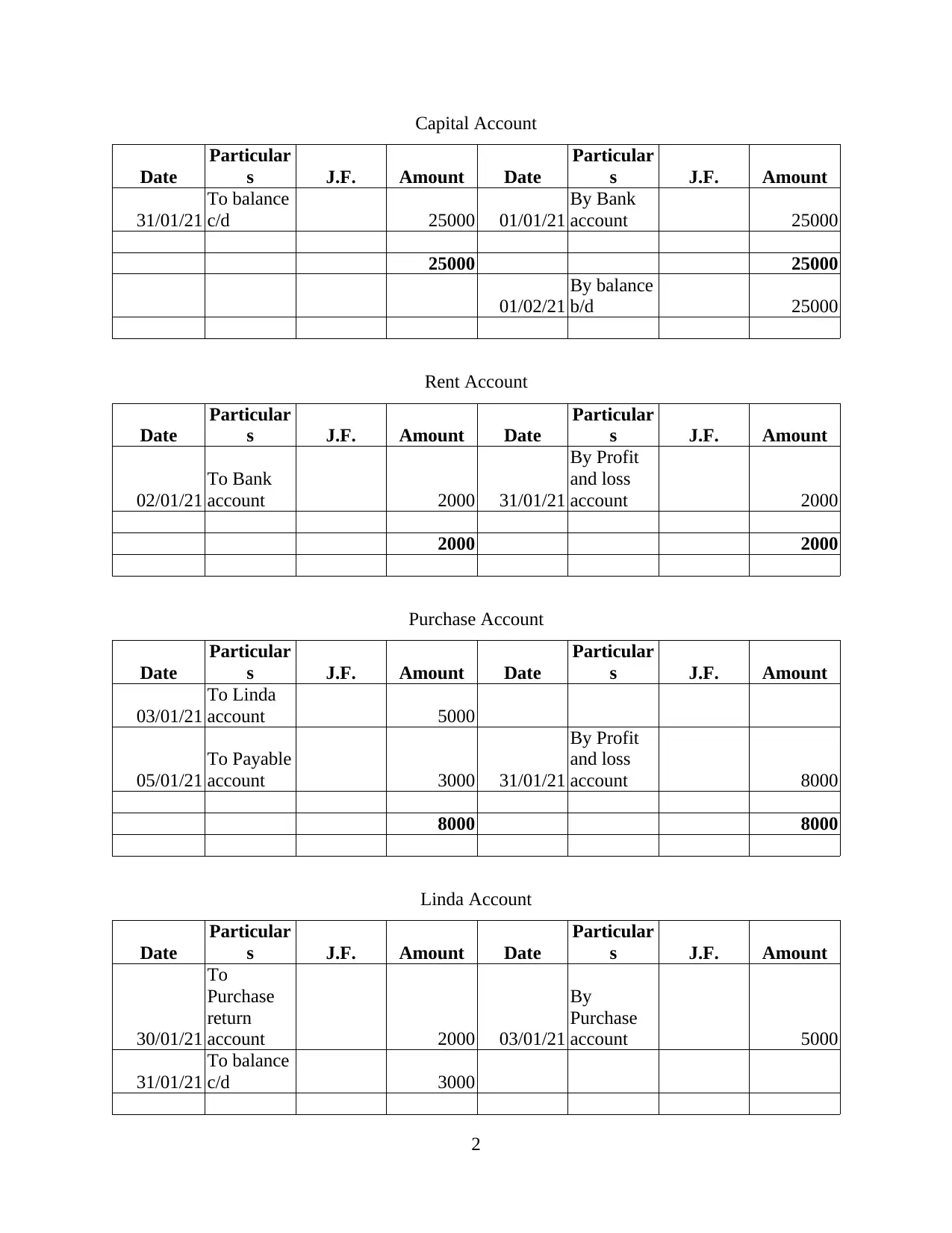
Capital Account
Date
Particular
s J.F. Amount Date
Particular
s J.F. Amount
31/01/21
To balance
c/d 25000 01/01/21
By Bank
account 25000
25000 25000
01/02/21
By balance
b/d 25000
Rent Account
Date
Particular
s J.F. Amount Date
Particular
s J.F. Amount
02/01/21
To Bank
account 2000 31/01/21
By Profit
and loss
account 2000
2000 2000
Purchase Account
Date
Particular
s J.F. Amount Date
Particular
s J.F. Amount
03/01/21
To Linda
account 5000
05/01/21
To Payable
account 3000 31/01/21
By Profit
and loss
account 8000
8000 8000
Linda Account
Date
Particular
s J.F. Amount Date
Particular
s J.F. Amount
30/01/21
To
Purchase
return
account 2000 03/01/21
By
Purchase
account 5000
31/01/21
To balance
c/d 3000
2
Date
Particular
s J.F. Amount Date
Particular
s J.F. Amount
31/01/21
To balance
c/d 25000 01/01/21
By Bank
account 25000
25000 25000
01/02/21
By balance
b/d 25000
Rent Account
Date
Particular
s J.F. Amount Date
Particular
s J.F. Amount
02/01/21
To Bank
account 2000 31/01/21
By Profit
and loss
account 2000
2000 2000
Purchase Account
Date
Particular
s J.F. Amount Date
Particular
s J.F. Amount
03/01/21
To Linda
account 5000
05/01/21
To Payable
account 3000 31/01/21
By Profit
and loss
account 8000
8000 8000
Linda Account
Date
Particular
s J.F. Amount Date
Particular
s J.F. Amount
30/01/21
To
Purchase
return
account 2000 03/01/21
By
Purchase
account 5000
31/01/21
To balance
c/d 3000
2
Paraphrase This Document
Need a fresh take? Get an instant paraphrase of this document with our AI Paraphraser
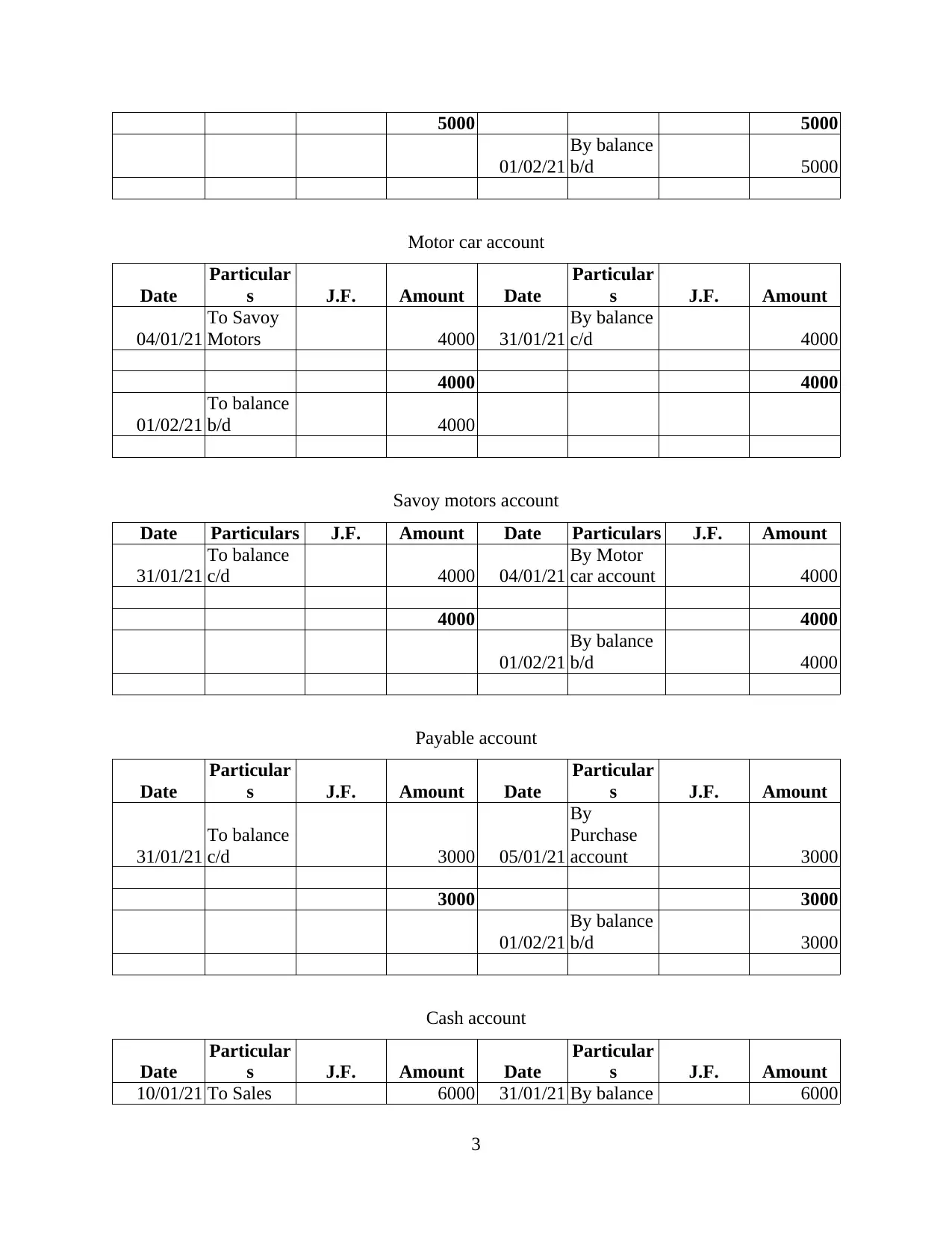
5000 5000
01/02/21
By balance
b/d 5000
Motor car account
Date
Particular
s J.F. Amount Date
Particular
s J.F. Amount
04/01/21
To Savoy
Motors 4000 31/01/21
By balance
c/d 4000
4000 4000
01/02/21
To balance
b/d 4000
Savoy motors account
Date Particulars J.F. Amount Date Particulars J.F. Amount
31/01/21
To balance
c/d 4000 04/01/21
By Motor
car account 4000
4000 4000
01/02/21
By balance
b/d 4000
Payable account
Date
Particular
s J.F. Amount Date
Particular
s J.F. Amount
31/01/21
To balance
c/d 3000 05/01/21
By
Purchase
account 3000
3000 3000
01/02/21
By balance
b/d 3000
Cash account
Date
Particular
s J.F. Amount Date
Particular
s J.F. Amount
10/01/21 To Sales 6000 31/01/21 By balance 6000
3
01/02/21
By balance
b/d 5000
Motor car account
Date
Particular
s J.F. Amount Date
Particular
s J.F. Amount
04/01/21
To Savoy
Motors 4000 31/01/21
By balance
c/d 4000
4000 4000
01/02/21
To balance
b/d 4000
Savoy motors account
Date Particulars J.F. Amount Date Particulars J.F. Amount
31/01/21
To balance
c/d 4000 04/01/21
By Motor
car account 4000
4000 4000
01/02/21
By balance
b/d 4000
Payable account
Date
Particular
s J.F. Amount Date
Particular
s J.F. Amount
31/01/21
To balance
c/d 3000 05/01/21
By
Purchase
account 3000
3000 3000
01/02/21
By balance
b/d 3000
Cash account
Date
Particular
s J.F. Amount Date
Particular
s J.F. Amount
10/01/21 To Sales 6000 31/01/21 By balance 6000
3
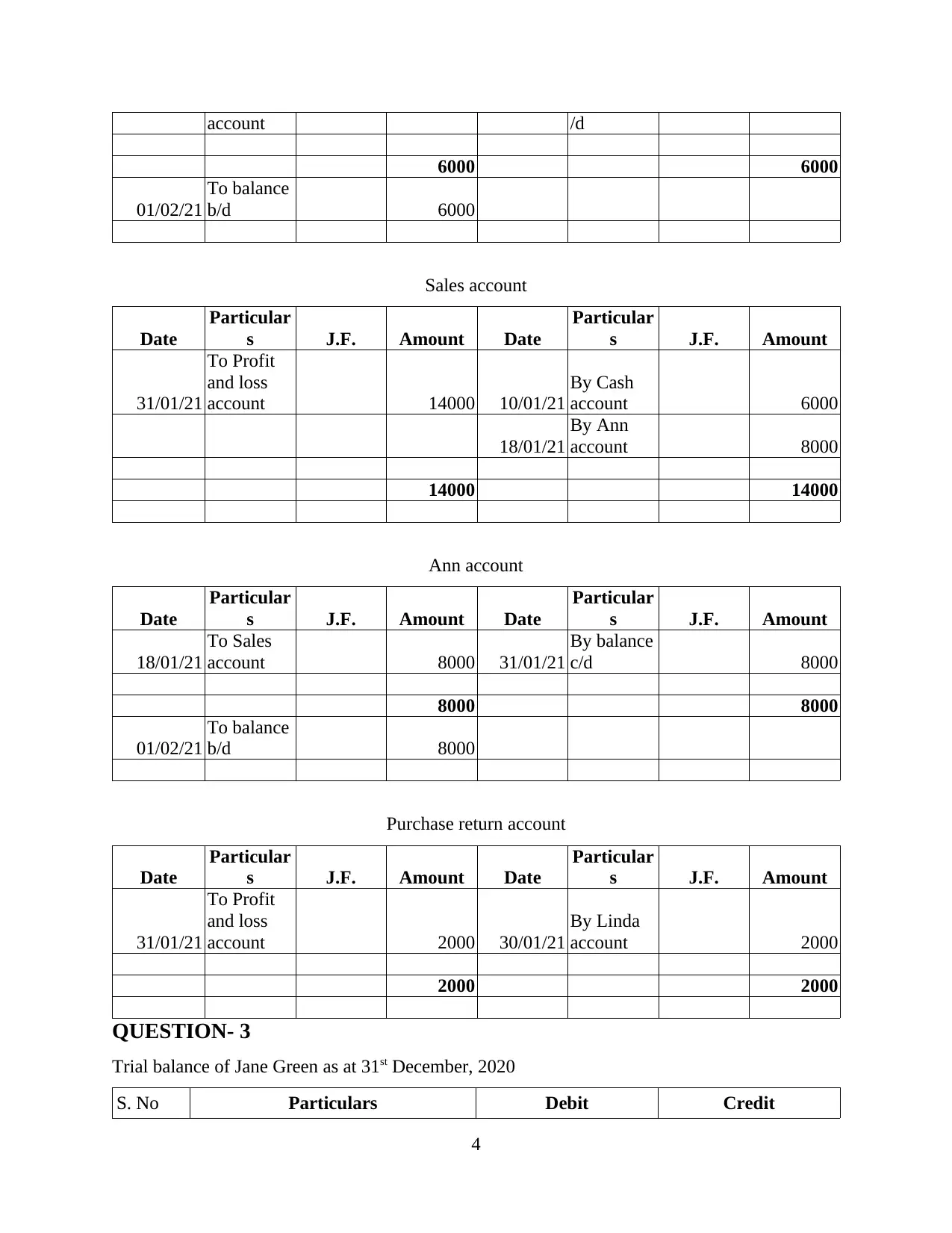
account /d
6000 6000
01/02/21
To balance
b/d 6000
Sales account
Date
Particular
s J.F. Amount Date
Particular
s J.F. Amount
31/01/21
To Profit
and loss
account 14000 10/01/21
By Cash
account 6000
18/01/21
By Ann
account 8000
14000 14000
Ann account
Date
Particular
s J.F. Amount Date
Particular
s J.F. Amount
18/01/21
To Sales
account 8000 31/01/21
By balance
c/d 8000
8000 8000
01/02/21
To balance
b/d 8000
Purchase return account
Date
Particular
s J.F. Amount Date
Particular
s J.F. Amount
31/01/21
To Profit
and loss
account 2000 30/01/21
By Linda
account 2000
2000 2000
QUESTION- 3
Trial balance of Jane Green as at 31st December, 2020
S. No Particulars Debit Credit
4
6000 6000
01/02/21
To balance
b/d 6000
Sales account
Date
Particular
s J.F. Amount Date
Particular
s J.F. Amount
31/01/21
To Profit
and loss
account 14000 10/01/21
By Cash
account 6000
18/01/21
By Ann
account 8000
14000 14000
Ann account
Date
Particular
s J.F. Amount Date
Particular
s J.F. Amount
18/01/21
To Sales
account 8000 31/01/21
By balance
c/d 8000
8000 8000
01/02/21
To balance
b/d 8000
Purchase return account
Date
Particular
s J.F. Amount Date
Particular
s J.F. Amount
31/01/21
To Profit
and loss
account 2000 30/01/21
By Linda
account 2000
2000 2000
QUESTION- 3
Trial balance of Jane Green as at 31st December, 2020
S. No Particulars Debit Credit
4
⊘ This is a preview!⊘
Do you want full access?
Subscribe today to unlock all pages.

Trusted by 1+ million students worldwide
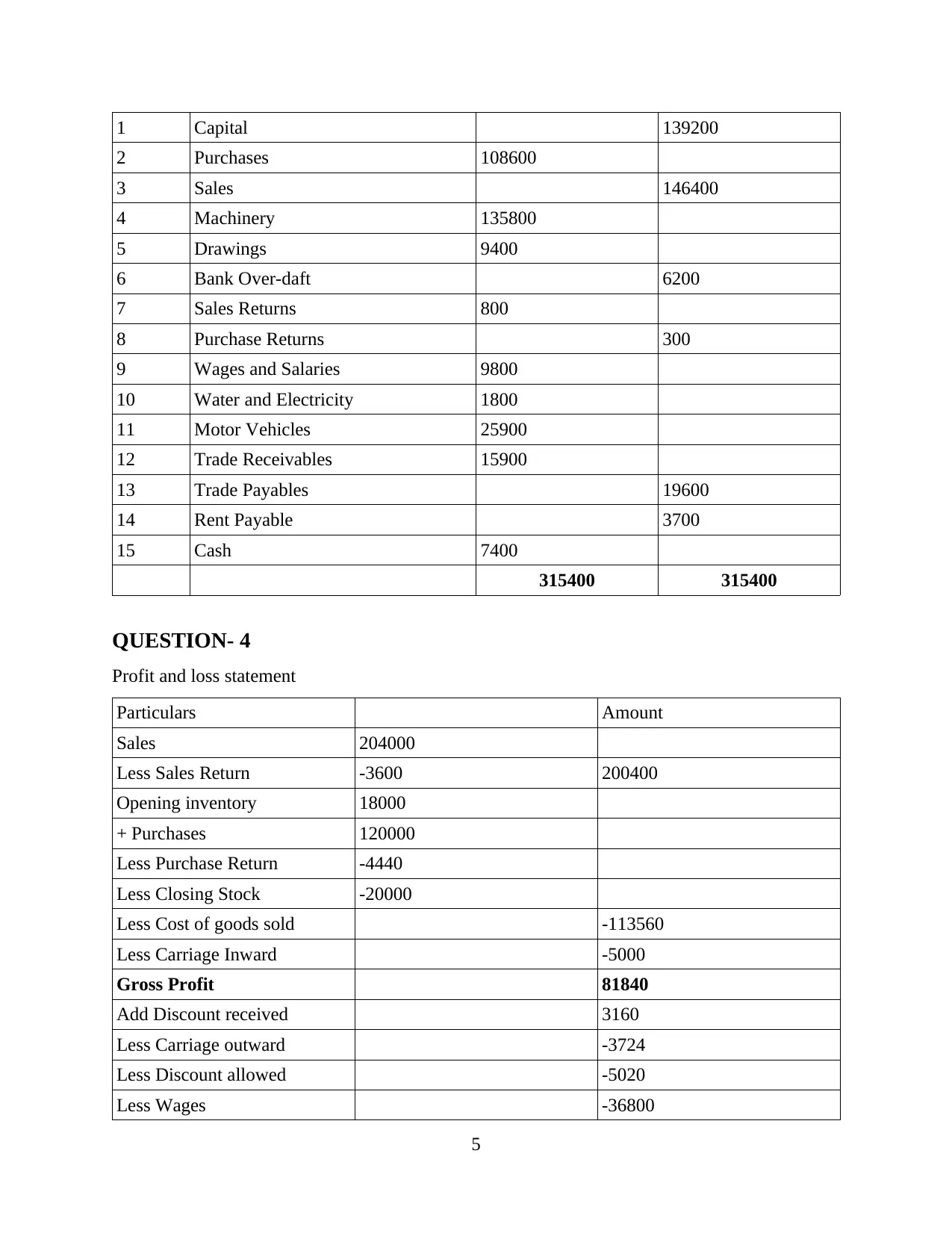
1 Capital 139200
2 Purchases 108600
3 Sales 146400
4 Machinery 135800
5 Drawings 9400
6 Bank Over-daft 6200
7 Sales Returns 800
8 Purchase Returns 300
9 Wages and Salaries 9800
10 Water and Electricity 1800
11 Motor Vehicles 25900
12 Trade Receivables 15900
13 Trade Payables 19600
14 Rent Payable 3700
15 Cash 7400
315400 315400
QUESTION- 4
Profit and loss statement
Particulars Amount
Sales 204000
Less Sales Return -3600 200400
Opening inventory 18000
+ Purchases 120000
Less Purchase Return -4440
Less Closing Stock -20000
Less Cost of goods sold -113560
Less Carriage Inward -5000
Gross Profit 81840
Add Discount received 3160
Less Carriage outward -3724
Less Discount allowed -5020
Less Wages -36800
5
2 Purchases 108600
3 Sales 146400
4 Machinery 135800
5 Drawings 9400
6 Bank Over-daft 6200
7 Sales Returns 800
8 Purchase Returns 300
9 Wages and Salaries 9800
10 Water and Electricity 1800
11 Motor Vehicles 25900
12 Trade Receivables 15900
13 Trade Payables 19600
14 Rent Payable 3700
15 Cash 7400
315400 315400
QUESTION- 4
Profit and loss statement
Particulars Amount
Sales 204000
Less Sales Return -3600 200400
Opening inventory 18000
+ Purchases 120000
Less Purchase Return -4440
Less Closing Stock -20000
Less Cost of goods sold -113560
Less Carriage Inward -5000
Gross Profit 81840
Add Discount received 3160
Less Carriage outward -3724
Less Discount allowed -5020
Less Wages -36800
5
Paraphrase This Document
Need a fresh take? Get an instant paraphrase of this document with our AI Paraphraser
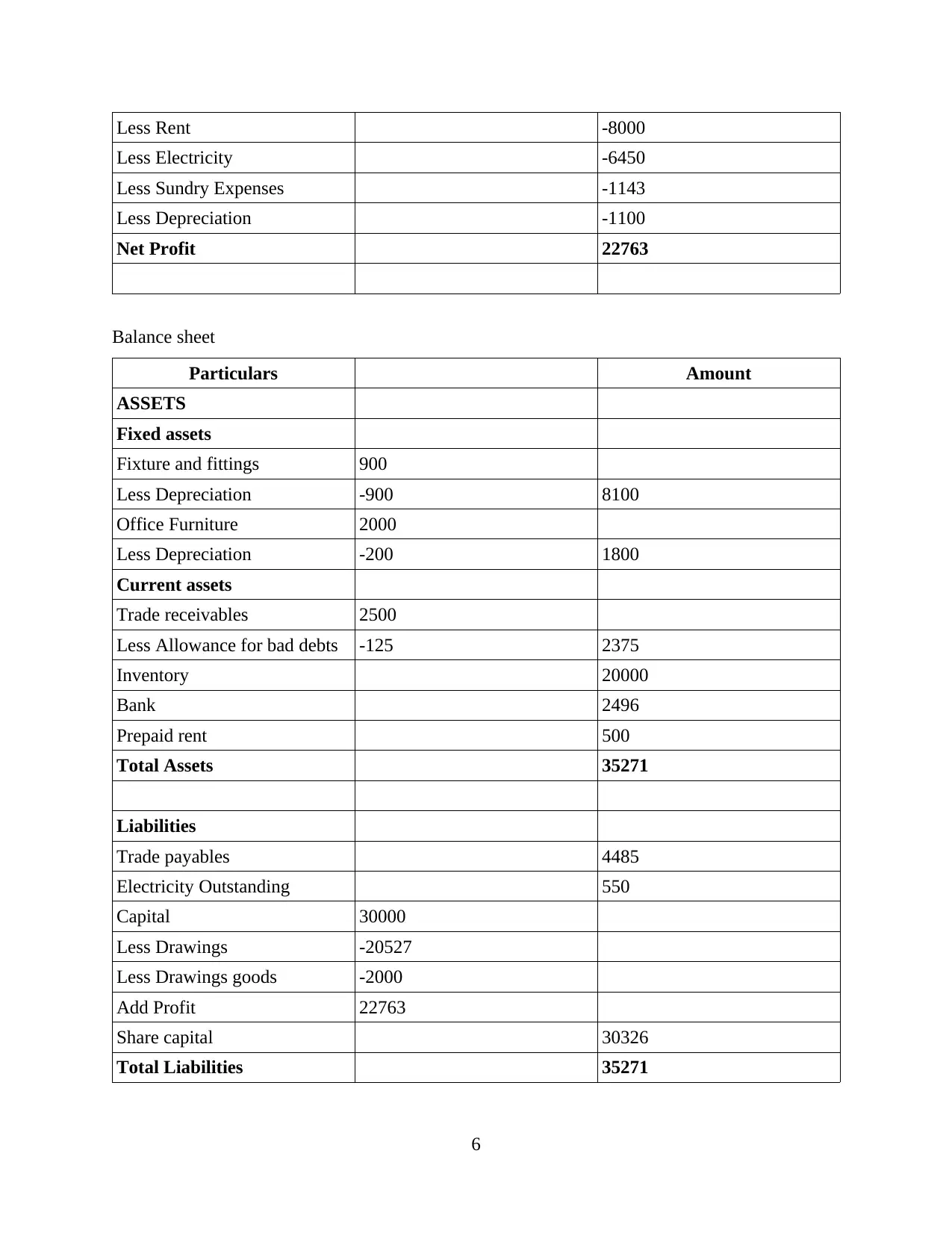
Less Rent -8000
Less Electricity -6450
Less Sundry Expenses -1143
Less Depreciation -1100
Net Profit 22763
Balance sheet
Particulars Amount
ASSETS
Fixed assets
Fixture and fittings 900
Less Depreciation -900 8100
Office Furniture 2000
Less Depreciation -200 1800
Current assets
Trade receivables 2500
Less Allowance for bad debts -125 2375
Inventory 20000
Bank 2496
Prepaid rent 500
Total Assets 35271
Liabilities
Trade payables 4485
Electricity Outstanding 550
Capital 30000
Less Drawings -20527
Less Drawings goods -2000
Add Profit 22763
Share capital 30326
Total Liabilities 35271
6
Less Electricity -6450
Less Sundry Expenses -1143
Less Depreciation -1100
Net Profit 22763
Balance sheet
Particulars Amount
ASSETS
Fixed assets
Fixture and fittings 900
Less Depreciation -900 8100
Office Furniture 2000
Less Depreciation -200 1800
Current assets
Trade receivables 2500
Less Allowance for bad debts -125 2375
Inventory 20000
Bank 2496
Prepaid rent 500
Total Assets 35271
Liabilities
Trade payables 4485
Electricity Outstanding 550
Capital 30000
Less Drawings -20527
Less Drawings goods -2000
Add Profit 22763
Share capital 30326
Total Liabilities 35271
6
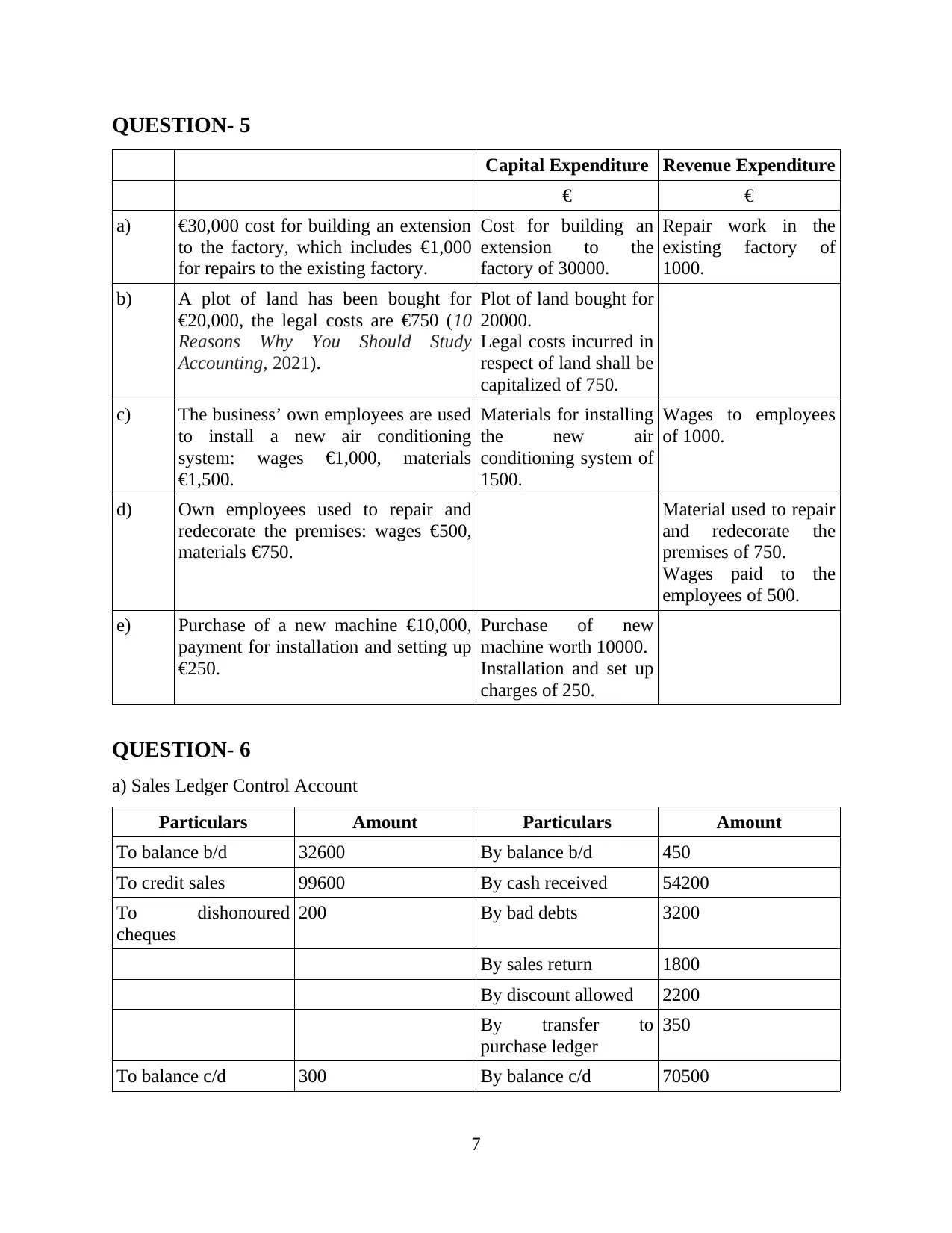
QUESTION- 5
Capital Expenditure Revenue Expenditure
€ €
a) €30,000 cost for building an extension
to the factory, which includes €1,000
for repairs to the existing factory.
Cost for building an
extension to the
factory of 30000.
Repair work in the
existing factory of
1000.
b) A plot of land has been bought for
€20,000, the legal costs are €750 (10
Reasons Why You Should Study
Accounting, 2021).
Plot of land bought for
20000.
Legal costs incurred in
respect of land shall be
capitalized of 750.
c) The business’ own employees are used
to install a new air conditioning
system: wages €1,000, materials
€1,500.
Materials for installing
the new air
conditioning system of
1500.
Wages to employees
of 1000.
d) Own employees used to repair and
redecorate the premises: wages €500,
materials €750.
Material used to repair
and redecorate the
premises of 750.
Wages paid to the
employees of 500.
e) Purchase of a new machine €10,000,
payment for installation and setting up
€250.
Purchase of new
machine worth 10000.
Installation and set up
charges of 250.
QUESTION- 6
a) Sales Ledger Control Account
Particulars Amount Particulars Amount
To balance b/d 32600 By balance b/d 450
To credit sales 99600 By cash received 54200
To dishonoured
cheques
200 By bad debts 3200
By sales return 1800
By discount allowed 2200
By transfer to
purchase ledger
350
To balance c/d 300 By balance c/d 70500
7
Capital Expenditure Revenue Expenditure
€ €
a) €30,000 cost for building an extension
to the factory, which includes €1,000
for repairs to the existing factory.
Cost for building an
extension to the
factory of 30000.
Repair work in the
existing factory of
1000.
b) A plot of land has been bought for
€20,000, the legal costs are €750 (10
Reasons Why You Should Study
Accounting, 2021).
Plot of land bought for
20000.
Legal costs incurred in
respect of land shall be
capitalized of 750.
c) The business’ own employees are used
to install a new air conditioning
system: wages €1,000, materials
€1,500.
Materials for installing
the new air
conditioning system of
1500.
Wages to employees
of 1000.
d) Own employees used to repair and
redecorate the premises: wages €500,
materials €750.
Material used to repair
and redecorate the
premises of 750.
Wages paid to the
employees of 500.
e) Purchase of a new machine €10,000,
payment for installation and setting up
€250.
Purchase of new
machine worth 10000.
Installation and set up
charges of 250.
QUESTION- 6
a) Sales Ledger Control Account
Particulars Amount Particulars Amount
To balance b/d 32600 By balance b/d 450
To credit sales 99600 By cash received 54200
To dishonoured
cheques
200 By bad debts 3200
By sales return 1800
By discount allowed 2200
By transfer to
purchase ledger
350
To balance c/d 300 By balance c/d 70500
7
⊘ This is a preview!⊘
Do you want full access?
Subscribe today to unlock all pages.

Trusted by 1+ million students worldwide
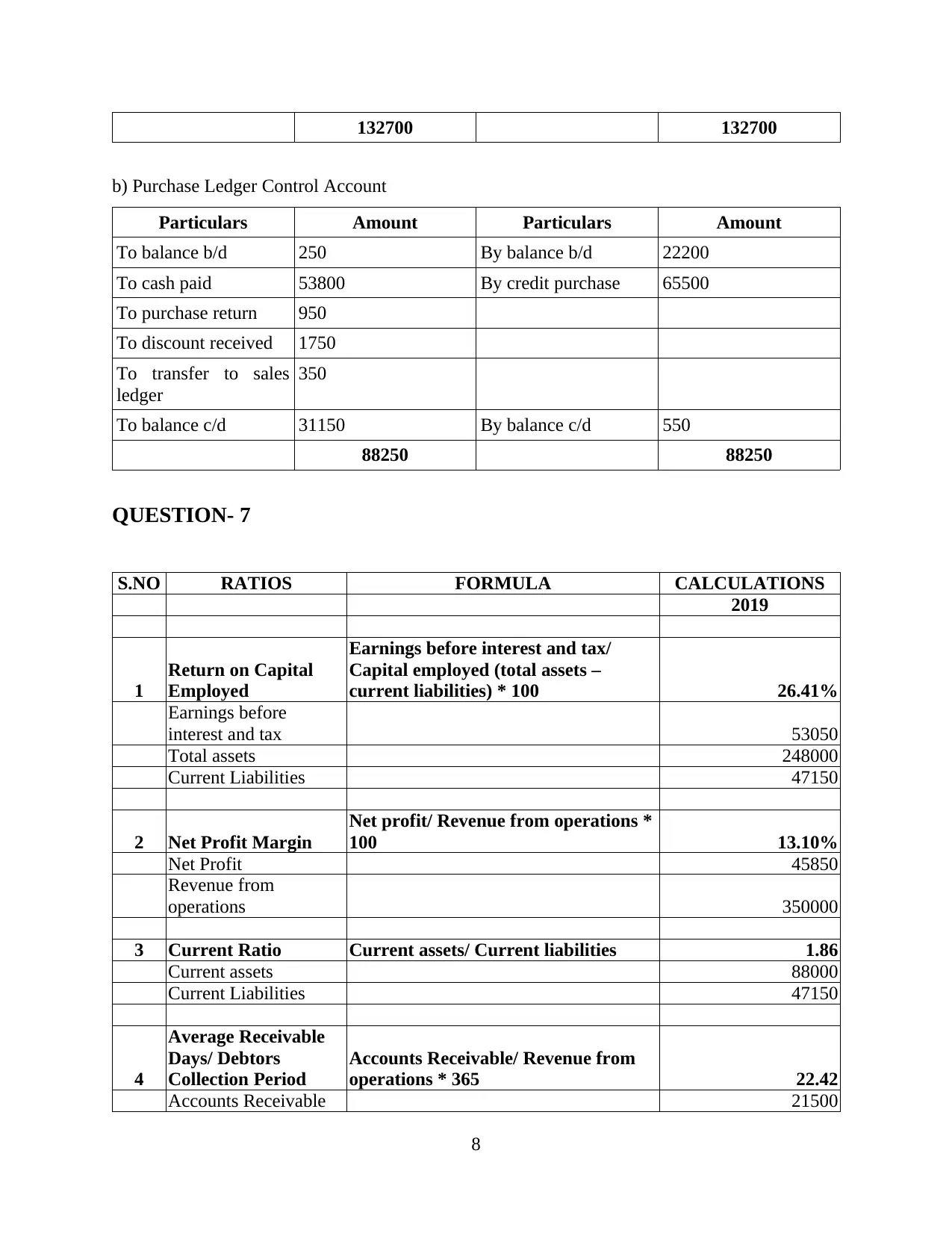
132700 132700
b) Purchase Ledger Control Account
Particulars Amount Particulars Amount
To balance b/d 250 By balance b/d 22200
To cash paid 53800 By credit purchase 65500
To purchase return 950
To discount received 1750
To transfer to sales
ledger
350
To balance c/d 31150 By balance c/d 550
88250 88250
QUESTION- 7
S.NO RATIOS FORMULA CALCULATIONS
2019
1
Return on Capital
Employed
Earnings before interest and tax/
Capital employed (total assets –
current liabilities) * 100 26.41%
Earnings before
interest and tax 53050
Total assets 248000
Current Liabilities 47150
2 Net Profit Margin
Net profit/ Revenue from operations *
100 13.10%
Net Profit 45850
Revenue from
operations 350000
3 Current Ratio Current assets/ Current liabilities 1.86
Current assets 88000
Current Liabilities 47150
4
Average Receivable
Days/ Debtors
Collection Period
Accounts Receivable/ Revenue from
operations * 365 22.42
Accounts Receivable 21500
8
b) Purchase Ledger Control Account
Particulars Amount Particulars Amount
To balance b/d 250 By balance b/d 22200
To cash paid 53800 By credit purchase 65500
To purchase return 950
To discount received 1750
To transfer to sales
ledger
350
To balance c/d 31150 By balance c/d 550
88250 88250
QUESTION- 7
S.NO RATIOS FORMULA CALCULATIONS
2019
1
Return on Capital
Employed
Earnings before interest and tax/
Capital employed (total assets –
current liabilities) * 100 26.41%
Earnings before
interest and tax 53050
Total assets 248000
Current Liabilities 47150
2 Net Profit Margin
Net profit/ Revenue from operations *
100 13.10%
Net Profit 45850
Revenue from
operations 350000
3 Current Ratio Current assets/ Current liabilities 1.86
Current assets 88000
Current Liabilities 47150
4
Average Receivable
Days/ Debtors
Collection Period
Accounts Receivable/ Revenue from
operations * 365 22.42
Accounts Receivable 21500
8
Paraphrase This Document
Need a fresh take? Get an instant paraphrase of this document with our AI Paraphraser
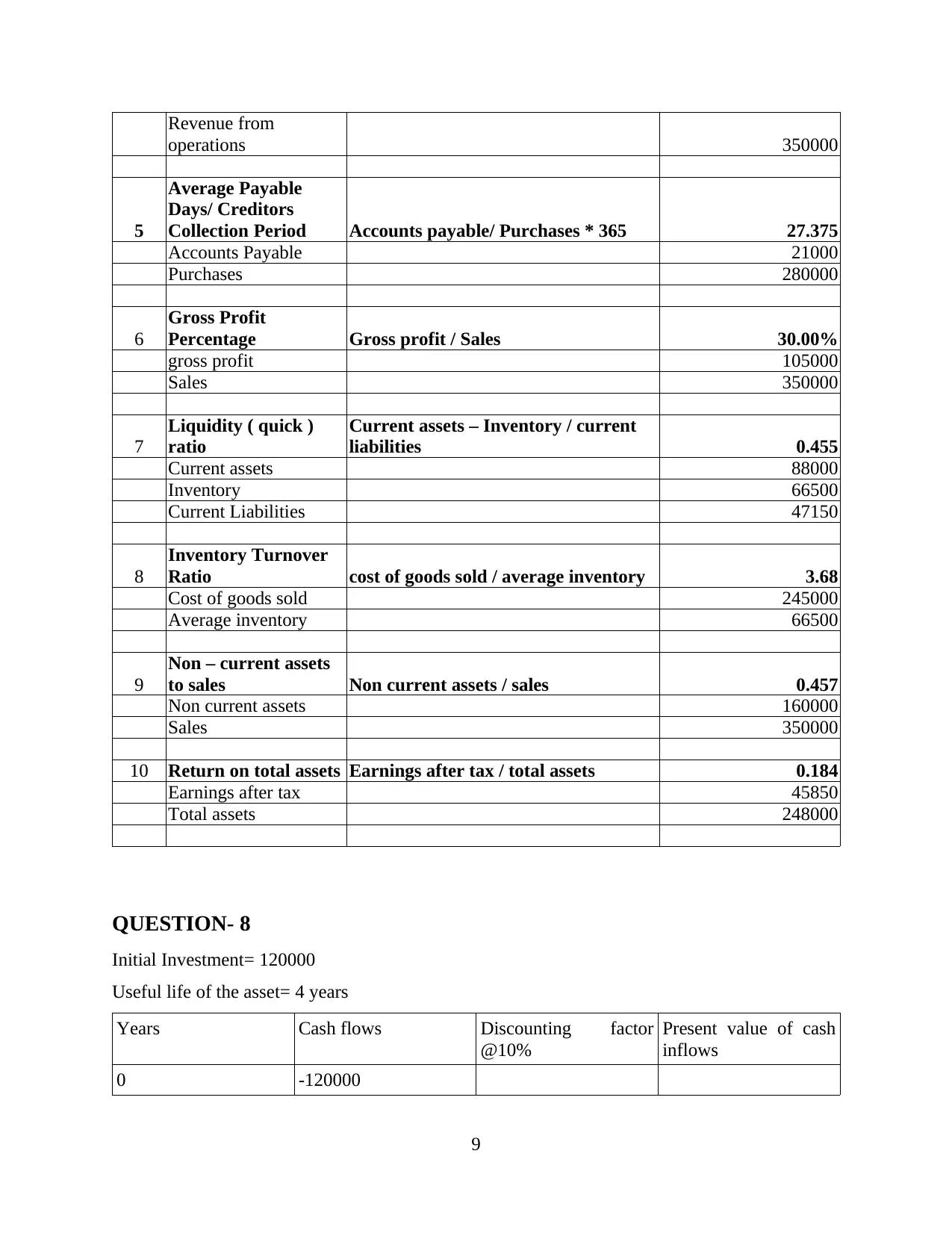
Revenue from
operations 350000
5
Average Payable
Days/ Creditors
Collection Period Accounts payable/ Purchases * 365 27.375
Accounts Payable 21000
Purchases 280000
6
Gross Profit
Percentage Gross profit / Sales 30.00%
gross profit 105000
Sales 350000
7
Liquidity ( quick )
ratio
Current assets – Inventory / current
liabilities 0.455
Current assets 88000
Inventory 66500
Current Liabilities 47150
8
Inventory Turnover
Ratio cost of goods sold / average inventory 3.68
Cost of goods sold 245000
Average inventory 66500
9
Non – current assets
to sales Non current assets / sales 0.457
Non current assets 160000
Sales 350000
10 Return on total assets Earnings after tax / total assets 0.184
Earnings after tax 45850
Total assets 248000
QUESTION- 8
Initial Investment= 120000
Useful life of the asset= 4 years
Years Cash flows Discounting factor
@10%
Present value of cash
inflows
0 -120000
9
operations 350000
5
Average Payable
Days/ Creditors
Collection Period Accounts payable/ Purchases * 365 27.375
Accounts Payable 21000
Purchases 280000
6
Gross Profit
Percentage Gross profit / Sales 30.00%
gross profit 105000
Sales 350000
7
Liquidity ( quick )
ratio
Current assets – Inventory / current
liabilities 0.455
Current assets 88000
Inventory 66500
Current Liabilities 47150
8
Inventory Turnover
Ratio cost of goods sold / average inventory 3.68
Cost of goods sold 245000
Average inventory 66500
9
Non – current assets
to sales Non current assets / sales 0.457
Non current assets 160000
Sales 350000
10 Return on total assets Earnings after tax / total assets 0.184
Earnings after tax 45850
Total assets 248000
QUESTION- 8
Initial Investment= 120000
Useful life of the asset= 4 years
Years Cash flows Discounting factor
@10%
Present value of cash
inflows
0 -120000
9
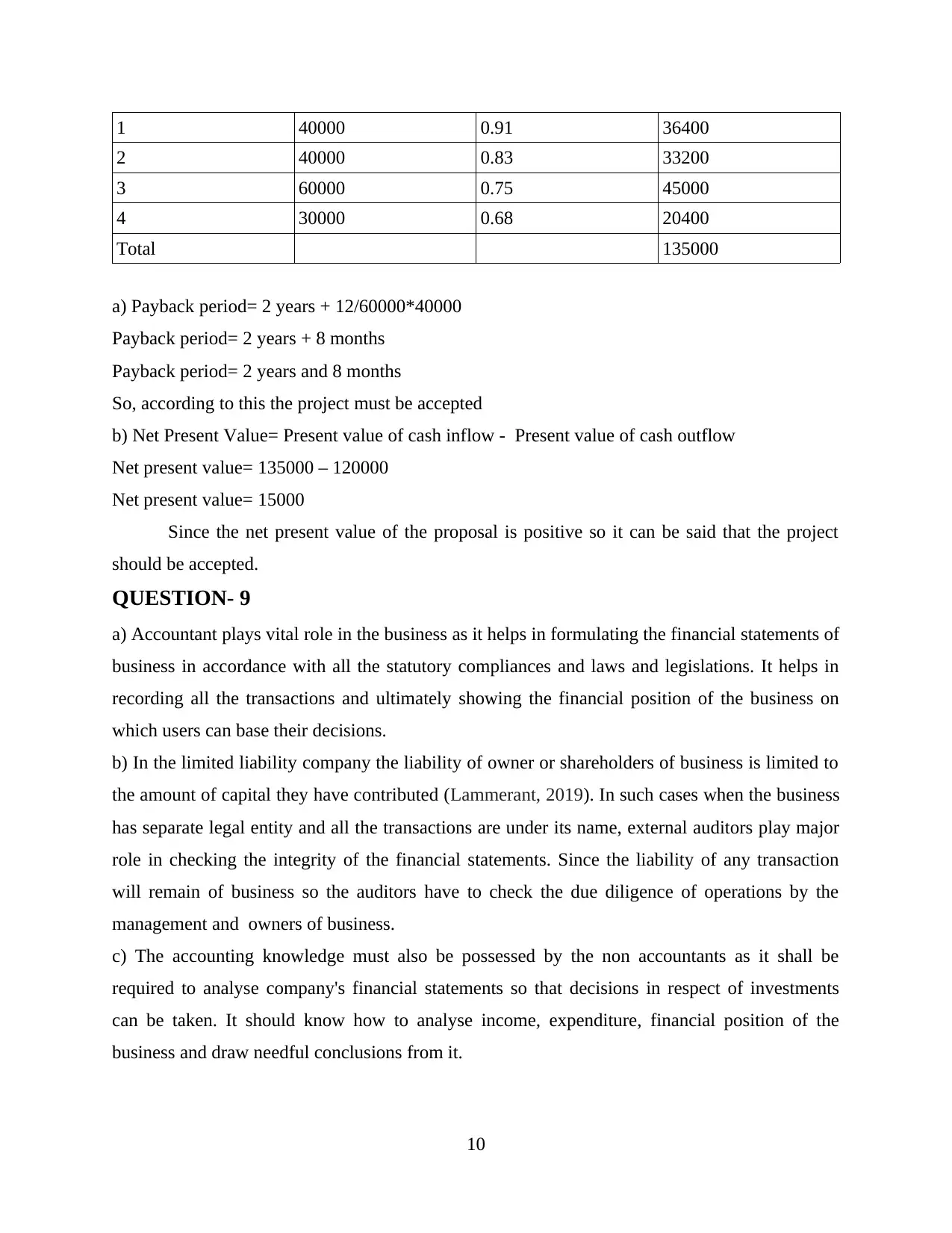
1 40000 0.91 36400
2 40000 0.83 33200
3 60000 0.75 45000
4 30000 0.68 20400
Total 135000
a) Payback period= 2 years + 12/60000*40000
Payback period= 2 years + 8 months
Payback period= 2 years and 8 months
So, according to this the project must be accepted
b) Net Present Value= Present value of cash inflow - Present value of cash outflow
Net present value= 135000 – 120000
Net present value= 15000
Since the net present value of the proposal is positive so it can be said that the project
should be accepted.
QUESTION- 9
a) Accountant plays vital role in the business as it helps in formulating the financial statements of
business in accordance with all the statutory compliances and laws and legislations. It helps in
recording all the transactions and ultimately showing the financial position of the business on
which users can base their decisions.
b) In the limited liability company the liability of owner or shareholders of business is limited to
the amount of capital they have contributed (Lammerant, 2019). In such cases when the business
has separate legal entity and all the transactions are under its name, external auditors play major
role in checking the integrity of the financial statements. Since the liability of any transaction
will remain of business so the auditors have to check the due diligence of operations by the
management and owners of business.
c) The accounting knowledge must also be possessed by the non accountants as it shall be
required to analyse company's financial statements so that decisions in respect of investments
can be taken. It should know how to analyse income, expenditure, financial position of the
business and draw needful conclusions from it.
10
2 40000 0.83 33200
3 60000 0.75 45000
4 30000 0.68 20400
Total 135000
a) Payback period= 2 years + 12/60000*40000
Payback period= 2 years + 8 months
Payback period= 2 years and 8 months
So, according to this the project must be accepted
b) Net Present Value= Present value of cash inflow - Present value of cash outflow
Net present value= 135000 – 120000
Net present value= 15000
Since the net present value of the proposal is positive so it can be said that the project
should be accepted.
QUESTION- 9
a) Accountant plays vital role in the business as it helps in formulating the financial statements of
business in accordance with all the statutory compliances and laws and legislations. It helps in
recording all the transactions and ultimately showing the financial position of the business on
which users can base their decisions.
b) In the limited liability company the liability of owner or shareholders of business is limited to
the amount of capital they have contributed (Lammerant, 2019). In such cases when the business
has separate legal entity and all the transactions are under its name, external auditors play major
role in checking the integrity of the financial statements. Since the liability of any transaction
will remain of business so the auditors have to check the due diligence of operations by the
management and owners of business.
c) The accounting knowledge must also be possessed by the non accountants as it shall be
required to analyse company's financial statements so that decisions in respect of investments
can be taken. It should know how to analyse income, expenditure, financial position of the
business and draw needful conclusions from it.
10
⊘ This is a preview!⊘
Do you want full access?
Subscribe today to unlock all pages.

Trusted by 1+ million students worldwide
1 out of 15
Related Documents
Your All-in-One AI-Powered Toolkit for Academic Success.
+13062052269
info@desklib.com
Available 24*7 on WhatsApp / Email
![[object Object]](/_next/static/media/star-bottom.7253800d.svg)
Unlock your academic potential
Copyright © 2020–2025 A2Z Services. All Rights Reserved. Developed and managed by ZUCOL.




